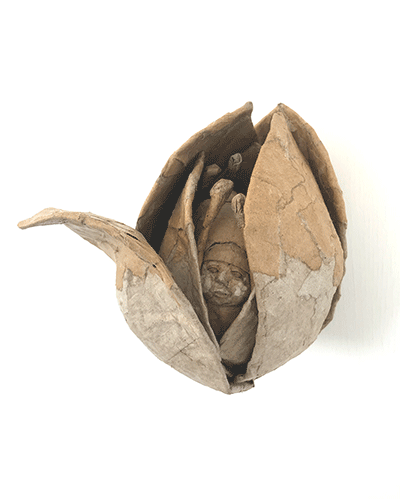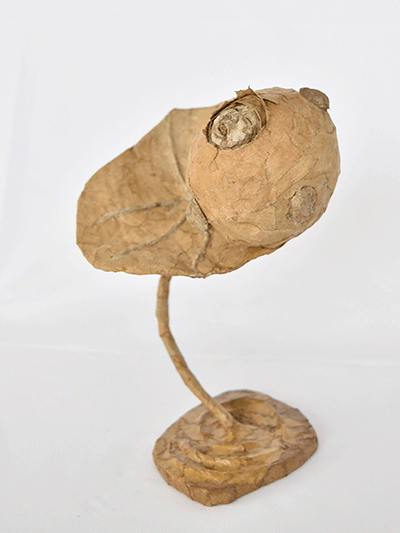�ʓc���I
�w�@���Y �|�����E�L���E���|�x
Tamada Taki
�gHasutaro �| Growth, Memory, and Rebirth�h
2019�N2��16��(�y)�`3��17���i���j 12:00�`19:00
���E�͋x�L
�M�������[ �L�h�v���X�ł́A2019�N2��16��(�y)����3��17��(��)�܂ŁA�_���{�[���݂̂�f�ނƂ��č�Ɗ����𑱂����N��12�N�ڂ��}����A�[�e�B�X�g�ʓc���I�̐^�����Ƃ�������V������Љ��W�u�@���Y �|�����E�L���E�Đ��|�v�W���J�Â������܂��B

�w�Ȃ��Ȃ��Q�Ȃ��x
�ʓc�͂���܂œ����⍩�������`�[�t�ɁA���Ɉ��炵�����Ƀ_�C�i�~�b�N�ȍ�i�\���A�_���{�[���Ƃ����g�߂ȑf�ނ��琧�삳�ꂽ�Ƃ����e�ߊ����V�i�W�[�݁A�q�ǂ����炨�ƂȂ܂ŕ��L���w�ɐl�C���W�߂Ă��܂����B�ߔN�_���{�[���ɒ��ڂ����A�[�e�B�X�g�̒��ł��ʓc��������悷��̂́A�_���{�[�����_���{�[���R�Ƃ��Ďg���̂ł͂Ȃ��A�p���v�ɂ܂ŊҌ�����Ȃǃ}�e���A�����̂��̂Ƃ��ĒNj����Ă���_�ɂ���ƌ�����ł��傤�B���̔w�i�ɁA���p��w������G�Ȃ��U�����ʓc�́A���G�̋�̂̌��E�������G�̋���g���̂��~�߁A�F���Ɏ䂩��E���Ă����}���~�L�T�[�ɂ�������̕����ƃ{���h�������h���h���ɂ��悤�Ƃ��铙�̎������J��Ԃ��Ă��܂����B���鎞�A����͎�������H���Ɠ����Ȃ̂ł͂Ȃ����ƋC�Â��Ɠ����ɒ��F�����̂悤�ȐF�����⊴�G���C�ɓ���A�_���{�[���Ɏ������ƌ��܂��B�_���{�[�������F�ʁE�f�ފ����ʓc�̔��ς̑ΏۂƂ��đ�����ꂽ�̂ł��B
�ʓc�̓_���{�[�����A���������ɂ����`��E���ݍ��`�ԁE�S�y�̂悤�ɂ�����Ԃɕω������Ȃ���A�悸�͍��i������A���t�����A�畆���悤�ɂ��Đ��삵�Ă䂫�܂��B

�w�C���C���x
����̓_���{�[���Ƃ����f�ނ������ɕω������邩�Ƃ����T���ł�����܂��B���F������Ȃ��ʓc�̍�i�́A���푽�l�Ȓ��n�F�̑w�����G�ɗ��ݍ����A�p���ڂ��̐Ղ������Ďc����@�͓Ɠ��ȕ������������A�܂�Ŗؒ��̂悤�ȋ��x�������d�オ��ɂȂ�܂��B�������̖ڂ̑O�Ɍ��ꂽ���̑��`���́A�_���{�[���Ƃ������t����z�������C���[�W��T�O���z���A�ʓc���n��o�������E�ςƂ��ċ��������͂������ė������ꖣ������ł��傤�B
���̂悤�ȑf�ނ����̂܂g�킸�ɕ����ω������č��グ�銈���͍�ƂɂƂ��āA�w�V���ȍĐ��x�Ƃ����R���Z�v�g�ŁA���𐁂����ނ悤�ɐ�������n�����邱�Ƃł�����ƌ����܂��B�����āA����̓e�[�}�����g�̐l���ɂ��d�ˍ��킹�A�q��ĂƐ̘b���璅�z���u�@���Y�i�͂����낤�j�v�Ȃ���̂���i�Ƃ��Đ��ݏo���A�_���{�[����f�ނƂ����V���Ȍ|�p�\���ɒ��݂܂��B�{�W�̏o�i��ł���@���Y�V���[�Y�́A�u�i�@�̉Ԃ́j�D���Z���قǑ�ւ��炩����v�Ƃ�����Ƃ̑z���Ƌ��ɁA�Î��_���{�[�����̌`�ɑh�点�A����Ԍn�̏z�E���㕶���Ƃ̊W�������������A�W�J���čs���܂��B�ʓc���n������@���Y�̐����E�L���E�Đ��̕�������Ђ��y���݂��������B
���ʓc���I�v���t�B�[����
1983�N���Ɍ����܂�@2007�N�������p��w���`�\���w�����`�w�ȑ���
���S�ȍĐ��Z�p�Ő��ݏo����錻����ے�����f�ށE�_���{�[�����g���u�V���ȍĐ��v�Ƃ����R���Z�v�g�ō��𐁂����ނ悤�ɐ������𐧍삵�Ă���B�����O�̓W����ATV���f�B�A��[�N�V���b�v�ł����͓I�Ɋ����B�_���{�[���̋��x�Ə_��������Ǝ��̋Z�@����p����̌���ł��L�߂Ă���B
2007�N �g�[�L���[�����_�[�E�H�[��������I
2010�N YOKOHAMA�n���E�GZAIM�R���y���
2010�N ���c�J��|�p�A���[�h�g���āh�����f�U�C��������
2016�N��������|�p�Ɣh�����Ɓ@�����������E���ǂ����p�����ٍ�i����
�W�����
2018�N
�p�ރA�[�g�W�@[�l�c�s���E���ǂ����p��]
�S�ؑ��ɐ��ޏ_�炩�����́@[MMM2018 �݂Ȃƃ��f�B�A�~���[�W�A��]
�ʓc���I�W�K���p�S�X�̐����������@[���l�s�_�ސ�斯�����Z���^�[���Ȃ����z�[��]
�_���{�[���̐������̓W�@[���}���c�c�C���Y]
�H�[�g��Zoo2018���m�ٓW����@[�u���t18�Ԋكz�[��]
���`��Ƌʓc���I�Ɩk��̎q�ǂ�����
�[�_���{�[�������̃^�}�S�W�[�@[�����s�k�敶���|�p���_�R�R�L�^]
2017�N
���`��Ƌʓc���I�̃_���{�[���A�[�g�W�@[����s�w�O�}����]
���`��Ƌʓc���I�@�_���{�[���̐������̓W�@[���s�����n���Z���^�[ala]
2016�N
�����ɂ����ԐX�@[���l�����h�}�[�N�^���[]
���`��Ƌʓc���I�Ƃ��������̎q�ǂ������W
�_���{�[���̊C�ɖ���V�[�h���S���̓`���@[�����������E�q�ǂ����p������]
�_���{�[�����炤�܂ꂽ�������̓W ���`��Ƌʓc���I�̐��E�@[���z�s������ق��Â���]
KEAT2016�������|�p�Ձ@[�Ȗ�]
�_���{�[�������ف@[�C�I�����[���������̐X]
Surajikund international crafts mela�@[�C���h]
ART NA OSYOGATSU�@[�V�h�ɐ��O]
2015�N
�ϑz���Ƃ܂�Ȃ��I�@[�O���O���n�E�X����]
�ʓc���I�̃_���{�[���A�[�g�W�@[�C�m���z�r�[�َl���\]
CAMOUFLAGE [�M�������[�����@��]
SENNHEISER�@[�R�E�B���h�f�B�X�v���C]
KEA2015�������|�p�Ձ@[�Ȗ�]
face to face�@[�V�h�ɐ��O]
2014�N
�_���{�[���E�A�j�}�����[���h�@[�L���������A������]
ART de FUKKO�@[���~���[�W�A���E�M�������[]
Art Wave Exhibition vol.28�@[RECT VERSO GALLERY]
�_���{�[���������@[��z�A�g���}���q��]
2013�N
�䑷�q���ۖ�O���p�W�@[�䑷�q]
�_���{�[���Ő�������낤�@[��̍��Ƃ�͂��|�p����PLAT]
�_���{�[���������@[��q�ʐ색�C�Y]
�t�B�����c�F���ی|�p�W�@[�����^�i�M�������[in�C�^���A]
�����B�̊G�{���y��@[hana cafe]
2012�N
being born�@[����ɓ���]
�_���{�[��Cooking�@[studio u5]
2011�N
�n������_���{�[���@[���c�J��|�p�A���[�h��i���\�W]
CARAN d�fACHE�@[����ɓ����E�B���h�f�B�X�v���C]
studio u5 artists archive vol.1�@[studio u5]
���p�ق͓������W�@[���������L�O�������p��]
�ʓc���I�W �o��Ƃ��@����Ƃ��@[studio u5]
2010�N
��݂�����C���W�@[MMM�݂Ȃƃ��f�B�A�~���[�W�A��]
ART IN KAGAWA ���˓����ی|�p�Պ֘A�C�x���g�@[e-�Ƃ҂�������]
�ʓc���I�W�@[Gallery coen&ZAIM cafe]
YKOHAMA�n���E�GZAIM�R���y��ܓW�@[���l]
2009�N
�����̐��A�[�g�s�N�j�b�N�@[����]
���܂ނ��W�@[����J�p�e�B�I �A�[�g�R���e�i]
2008�N
���܂ނ��������@[�M�������[��]
2007
�g�[�L���[�����_�[�E�H�[���@[�����s������p��]
���[�N�V���b�v��
�������܃X�[�p�[�A���[�i�A��c�惊���[�X�A�[�g�u���A������M�����N�V�e�B�[�A���ہ[��TOKYO-BAY
NHK�����Z�p�������A���ʐM�𗬊�e-�Ƃ҂� ������ADIY HOMECENTER SHOW 2010�i�������b�Z�j
�m�g�j���L�����y�[���n���G�R�C�x���g�i�m�g�j�j�A��q�ʐ색�C�Y�A�C�[�A�X���A�_�C�I�E�C�J����낤�i3331�j
������Ƃȏm�i�Y�o�w���j�A��̍��Ƃ�͂��|�p���� PLAT�A���Ɍ|�p�Ձ@�i���Ɂj
�G�R�X�����_�[�p�[�N2009�i���l�s�����j�A���͌��s���������c��� ���ǂ����p���[�N�V���b�v�i���͑��j
�n�}�L�b�Y�A�[�g�N���u�@���ʍu�t�i���l�s���M�������[�j�A�g�쒬�A�[�g���q�� �i�g�쒬�s���v���U�j
�����ȃA�[�g�t�F�X�i�b����K�[�f���v���C�X�A���l�����h�}�[�N�^���[�j�A���c�J����V�l�{�݁A���w�Z�Ȃǁ@
�������J�ÁB
Taki Tamada Solo Exhibition
�gHasutaro �| Growth, Memory, and Rebirth�h
Period: February 16 (Sat.) �| March 17 (Sun.), 2019
Gallery hours: 12:00 - 7:00 p.m. *5:00 p.m. on the last day
Closed on Mondays, Tuesdays, and holidays
Opening reception with the artist: February 16 (Sat.), 2018, 6:00 - 8:00 p.m.
From February 16 (Sat.) to March 17 (Sun.), 2019, Gallery KIDO Press is presenting a solo exhibition by Taki Tamada, who is entering her 12th year of activities as an artist. Titled �gHasutaro �| Growth, Memory, and Rebirth,�h the exhibition will introduce new works showcasing the essence of the art of Tamada, who produces works using only cardboard.
Taking animals and insects as her motifs, Tamada has thus far created pieces that are sometimes heartwarming and sometimes dynamic in character. The sense of affinity that comes from use of everyday cardboard generates a synergy that has helped to make her art popular with a diverse audience in all age groups, from young to old. Tamada is set apart from other artists who have taken note of cardboard in recent years by her rigorous pursuit of it as material going back to the level of pulp as opposed to its mere use as is. Behind this pursuit lie doings in her university days, when she majored in oil painting. Feeling the limits of oil paints themselves, she stopped using them and repeatedly experimented with other materials as painting media. For example, she sometimes collected twigs whose color attracted her, put them into a blender to pulverize them, and then mixed the resulting wooden powder with bonding agent to get the proper consistency. At some point, it occurred to her that this might be the same process as that for making paper. She was simultaneously drawn to the color and texture resembling those of brown paper. She said that this eventually led her to cardboard, whose color and physical feel were taken as objects of her esthetic sensibility.
In producing works, Tamada makes the skeleton first, then adds the fleshy parts, and finally covers them with skin or hide. In the process, she changes the state of the cardboard by peeling strips off to get paper, crumpling such paper, and working it into a clay-like condition. This process is also an exploration of ways in which cardboard as a material can be altered. Tamada�fs works are not painted or colored at all; they are complicated interweavings of layers of various brown hues, and the joints and seams are left exposed. This technique breeds a distinctive texture, and the finished work has the strength of a wooden sculpture. The figures so formed that appear before our eyes transcend the ideas and preconceptions associated with the word �gcardboard.�h As powerful statements of Tamada�fs outlook on life, these creations of hers have a unique presence and fascination.
As noted above, in making art, Tamada deconstructs and changes the material instead of using it as is. She says that, for her, this is also the creation of beings, as if she were ensouling the works under the concept of a �gnew rebirth.�h For the works in this exhibition, she superimposed the theme on her own life and produced the �gHasutaro�h series inspired by her experience of child-raising and children�fs stories. In so doing, she took up the challenge of a new round of artistic expression with cardboard. This �gHasutaro�h series springs from the artists belief that the lotus (�ghasu�h) has a bigger flower if its roots lie in thicker mud. At the same time, the rebirth of used cardboard in the form of living creatures hints at relations with the cycles of life and ecosystems, and with contemporary civilization. We urge all to come and see the narrative of growth, memory, and rebirth as embodied in Tamada�fs �gHasutaro�h series.
We would be delighted to obtain the cooperation of your newspaper or magazine with publicity for this exhibition, and appreciate your support.
�� Profile of Taki Tamada ��
Born in Hyogo Prefecture in 1983, Tamada graduated from the Department of Fine Arts at Tama Art University in 2007. Using cardboard as a material symbolizing the modern age born of perfected regenerative technology, she produces works depicting living creatures that seem to be ensouled under her concept of a �gnew rebirth.�h She is in extensive activity in exhibitions inside and outside Japan, TV media, and workshops. Her original techniques taking full advantage of cardboard�fs strength and pliability are coming into widespread use on the sites of art education as well.
2007: Selection for the Tokyo Wonder Wall Exhibition
2010: Receipt of an award in the Yokohama Creative Neighborhoods ZAIM project
2010: Receipt of an award in the design category in the Setagaya Art Award �gFlight�hcompetition
2016: Selection under the Agency for Cultural Affairs program for dispatch of artists; Selection of works by the Okazaki World Children�fs Art Museum for its collection
Exhibitions
*Note: All titles of exhibitions are tentative translations of the Japanese titles.
2018
�gExhibition of Art Made with Waste Materials�h (Hamada Children�fs Museum of Art
�gSoft Things Hidden in Byakkagura�h(MMM Minato Media Museum 2018)
�gTaki Tamada Exhibition �| Creatures of the Galapagos�h(Kanack Hall, Kanagawa Ward Culture Center, Yokohama)
�gCardboard Creatures Exhibition,�h Machida Tokyu Twins
�gKobo Noren Zoo 2018 Seiyokan Exhibition�h (Bluff No. 18 Hall)
�gFormative Artist Taki Tamada and the Children of Kita Ward �| Cardboard Dinosaur Egg Exhibit�h(Cocokita Center of Culture and Art, Kita Ward, Tokyo)
2017
�gFormative Artist Taki Tamada Cardboard Art Exhibition�h(Ikoma Ekimae Library Room)
�gFormative Artist Taki Tamada �| Exhibition of Cardboard Creatures�h (Kani Public Arts Center ala)
2016
�gThe Forest Floating in the Clouds�h(Yokohama Landmark Tower)
�gFormative Artist Taki Tamada and Okazaki Children�fs Exhibition �| The Legend of Sea Dragons Sleeping in a Cardboard Ocean�h (Okazaki World Children�fs Art Museum
�gExhibition of Creatures Born from Cardboard �| The World of Formative Artist Taki Tamada�h (Chofu City Cultural Hall Tazukuri)
�gKEAT 2016 Koisago Environmental Art Triennale�h (Tochigi)
�gCardboard Aquarium�h (Aeon Mall Tamadaira no Mori)
�gSurajikund International Crafts Mela�h (India)
�gART NA OSYOGATSU�h (Shinjuku Isetan)
2015
�gThe Daydreams Won�ft Stop!�h(Guruguru House Takayanagi)
�gTaki Tamada Cardboard Art Exhibition�h (Kayodo Hobby Museum Shimanto)
�gCAMOUFLAGE�h (Gallery Ruevent)
�gSENNHEISER�h (Aoyama Window Display)
�gKEAT 2015 - Koisago Environmental Art Triennale�h (Tochigi)
�gface to face�h (Shinjuku Isetan)
2014
�gCardboard Animal World�h(Toyohashi Zoo and Botanical Park)
�gART de FUKKO�h (Iwasaki Museum Gallery)
�gArt Wave Exhibition vol.28�h(RECT VERSO GALLERY)
�gCardboard Zoo�h (Kawagoe Atre Maruhiro)
2013
�gCardboard Zoo�h (Futako-Tamagawa Rise)
�gFlorence International Art Exhibition�h (Galleria d�fArte Mentana, Italy)
2012
�gbeing born�h (Ginza Itoya)
�gCardboard Cooking�h (studio u5)
2011
�gCreating Cardboard�h (Exhibition of Setagaya Art Award Works)
Workshops
Holding of numerous workshops in all parts of Japan
�� Contact ��
Gallery KIDO Press
3331 Arts Chiyoda, No. 204
6-11-14 Soto-Kanda
Chiyoda Ward, Tokyo, 101-0021 Japan
Tel: 03-5817-8988
E-mail: printart@kidopress.com
Web: www.kidopress.com
Gallery hours: 12:00 - 7:00 p.m. (closed on Mondays, Tuesdays, and holidays)

